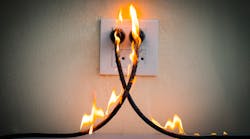While stop, drop, and roll! is an elementary school mantra and every homeowner has had to fan the fumes of a burnt pizza from the smoke detector, there's a serious gap in employees' fire safety knowledge between the home and the workplace. The more demanding the environment, the more comprehensive your fire safety strategy should be, and manufacturing facilities have a unique set of concerns.
From the corporate office to the plant floor, every part of the building must be considered before, during, and after the build-out process to ensure that your plans exceed compliance. Beyond the physical layout, promoting a culture that respects fire safety standards is key to a functional disaster plan.
The U.S. Fire Administration (USFA) maintains statistics for fire losses, injuries, and deaths for nonresidential buildings, including manufacturing and office environments. Between 2003 and 2017, an average of 5,180 fires broke out annually, attributed to everything from natural causes or, at both the #1 and #2 most common occurrences, equipment failure. These staggering statistics are a reminder that there is no such thing as a workplace that's too prepared, and that process starts from the ground up.
Start with consistent standards
To close the gap between common sense and specifics, ensure that employees start out with a uniform rundown of safety standards. While some may have existing knowledge, not everybody will be on the same page and incorporating a fire safety plan into orientation puts your workforce on even footing.
Beyond posting evacuation plans in legally-required locations, take a moment to go over the best paths of egress and physically show employees the locations of exits, fire alarms, detection systems, sprinkler systems, and fire extinguishers. Don't forget to explain the differences between extinguishers-- the chemicals that work on one fire won't work on every one and the dynamic nature of a manufacturing plant can cause a number of fire types.
Maintain this knowledge and keep your employees on the right path by conducting routine fire drills, ideally at times when the building is fully-staffed and across different shifts, if applicable. Smoke detectors and other indicators, whether small units or building-wide systems, should be checked both by personnel as well as local fire authorities. This includes sprinkler systems, which should be optimized with either a high-pressure water-driven system or a chemical foam that is well-suited to your industry.
Remember Electric Upgrades
Electrical fires are a leading cause of fire losses--and even death--in nonresidential environments. In offices, this is the second most common fire starter, while in manufacturing facilities it is the sixth. The USFA's data from 2003 to 2017 reveals that nearly every type of fire has become scarcer as safety regulations and knowledge increases, especially electrical fires.
Preventing electrical fires requires work up front with great benefits later on:
- Start with a professional inspection and evaluation from a reputable electrician
- Update, upgrade, and overhaul electrical wiring as needed; don't be afraid to go beyond basic requirements
- Teach all employees the warning signs of electrical issues
o Dim and flickering lights
o Unusual sizzling and buzzing
o Repeated tripping of breakers
- Reduce use of electrical cords and overloaded outlets
- Install outlet caps on any unused outlets that are being concealed by furniture
- Make sure that every socket has the correct lightbulb type and wattage
- Evaluate equipment in both office and plant environments; replace or repair items with outdated or weathered cords
Follow the Rules
To get started, look to resources such as legally-mandated codes and fire authorities’ websites. This will ensure that your environment is brought up to code while giving you the opportunity to go above and beyond the simple standards. Anticipate changes and enhancements in order to stay ahead of new regulations and ensure that you continue to have your workplace inspected to maintain compliance.
Online resources provide the best framework for getting started. The Fire Equipment Manufacturers' Association has put together an impressive list of safety resources that provide valuable statistics, important insights, and official instructions for maintaining a fire-safe work environment. From a national perspective, The U.S. Fire Administration provides official government resources and documentation that can be viewed as an overarching authority.
Avoid One-Size-Fits-All Solutions
Prepare for the potential devastation that a fire can impart by determining the right protection solutions for your business. Irreplaceable documents, small and specialized equipment, and critical backups are never immune to fire damage, and even metal cabinets cannot protect from the heat of a blaze. Specialized gypsum-lined file cabinets and safes are available to protect these important elements that are essential to day-to-day operations.
Choose the suite of features that best suits the type of fires that can break out. The majority of these cabinets have been designed with standards set by Underwriter Laboratories (UL), which consider a number of factors, including:
- Length of time burning at a certain temperature, maintaining an interior temperature of 350°F
- Ability to protect digital media, which has a significantly lower maximum temperature of 125°F
- 2,000° explosion hazard rating, which is especially relevant in manufacturing plants that use highly explosive materials
- Impact rating to protect items in case a floor burns out and the unit drops up to 30' and continues to burn
Whether you're optimizing the manufacturing facility itself or an attached office space, these environments are always unique and there's no one-size-fits-all solution for protecting both employees and business necessities. Careful consideration saves lives and can be the difference between a total loss and a salvageable operation. There's no such thing as too much disaster preparation, so consult your regulatory authorities and begin this process before it's too late.
Tonya Dybdahl is a space planning and design assistant manager for National Business Furniture.
